Eating low-carb while dining out is easier than you think, and don't shy away from butter! Start by ditching starchy sides like bread and pasta. Instead, choose salads or extra veggies. When ordering, ask for additional butter or healthy fats like olive oil to enhance flavor and keep you satisfied. For protein, go for options like grilled meats or cheese. Be clear with your server about your preferences to guarantee your meal fits your low-carb diet. If you're curious about more dining tips and choices to stay on track, there's plenty more to explore!
Key Takeaways
- Request extra butter or olive oil to enhance flavor and increase satiety in your low-carb meals.
- Opt for protein-rich dishes like meats and cheese while avoiding starchy sides.
- Choose healthy fats as part of your meal to maintain energy levels and satisfaction.
- Be clear with servers about your low-carb preferences to ensure suitable dish preparation.
- Enjoy low-carb desserts like berries with cream or dark chocolate for a satisfying finish.
General Low-Carb Dining Tips
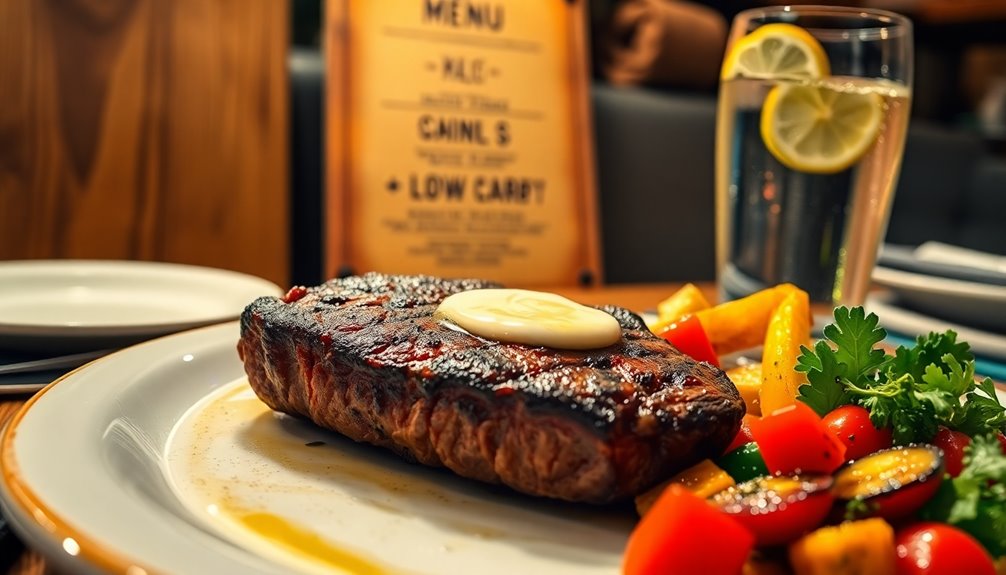
When dining out, a few smart strategies can make your low-carb experience enjoyable and satisfying.
Start by eliminating starchy sides like bread, pasta, and rice. Instead, request salads or extra veggies to accompany your meal. Incorporating low-carb options like spinach or broccoli can further enhance the nutritional value of your meal. Consider adding a protein-rich option such as turkey bean to your salad for a balanced dish. Remember that diversification in your food choices can also contribute to a balanced diet.
Don't shy away from adding healthy fats; ask for extra butter or olive oil to enhance flavor and satisfaction. These fats can help you feel more satiated and prevent cravings throughout the day.
Be mindful of sauces and condiments—request them on the side to control portions and avoid hidden sugars.
Choose drinks wisely; water, sparkling water, and dry wine are great options.
Finally, assess your hunger before considering dessert. If you're not genuinely hungry, skip it and enjoy a cup of coffee or tea instead.
Incorporating these strategies can help you maintain your low carbohydrate intake while savoring your dining experience. These tips will help you stay on track while savoring your dining experience.
Strategies for Buffets
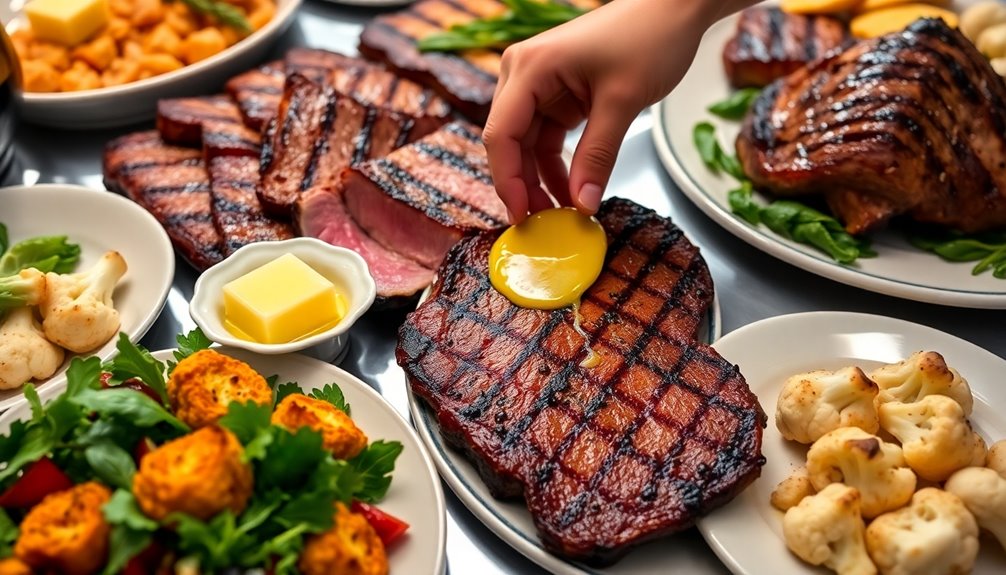
Dining at buffets can present unique challenges for those following a low-carb lifestyle. To navigate these, set clear rules before you eat. Decide to avoid grains, potatoes, and sugar, and stick to low-carb options.
Start with a small plate to control portions and encourage mindful eating. Focus on proteins, healthy fats, and non-starchy vegetables, prioritizing salad bars and carving stations. Engaging in interactive play with your family can also help create a positive dining atmosphere, making it easier to stick to your dietary choices. Communicate your dietary needs with the host if possible, so they can help accommodate you.
Preempt hunger by snacking on low-carb foods beforehand, which helps resist temptations. Finally, remember that you can always go back for more if you're still hungry, but sticking to your guidelines will keep you on track with your low-carb goals. Additionally, consider the best interests of the child when navigating family dining situations to ensure everyone feels included and comfortable.
Navigating Different Cuisines

Exploring different cuisines while sticking to a low-carb diet can be both enjoyable and rewarding.
When you dine at a Mexican restaurant, go for burrito bowls loaded with meats, cheese, and guacamole, skipping the rice and chips.
In Asian cuisine, choose stir-fries or brown sauce dishes, steering clear of battered or sweet options.
At Indian restaurants, enjoy kebabs and creamy curries, avoiding rice and naan.
Fast food? Opt for salads topped with proteins and use lettuce wraps instead of buns.
If pizza's on the menu, embrace toppings while minimizing crust.
Each cuisine offers unique flavors, so don't hesitate to customize your meals to keep your low-carb goals intact while savoring diverse dishes.
Mindful Eating Practices
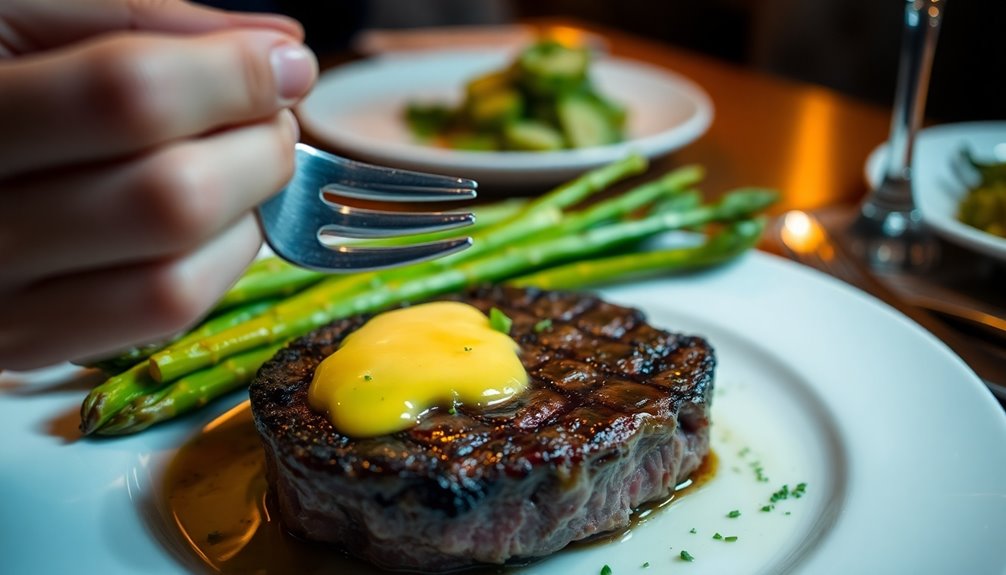
Mindful eating practices can greatly enhance your dining experience and support your low-carb goals. By focusing on the flavors and textures of your food, you can enjoy each bite and make better choices.
Here are some tips to incorporate mindfulness into your meals:
- Take your time: Savor each bite and engage in conversation, allowing your body to signal fullness. Incorporating goal setting can help you stay focused on your eating objectives. Additionally, practicing mindful eating techniques can help you develop a deeper awareness of your food choices. Research shows that hydration plays a key role in maintaining optimal brain function, which can influence your eating decisions. Regular dental check-ups also contribute to overall health, making it easier to enjoy a variety of foods.
- Limit distractions: Put away your phone and focus on the meal and company around you.
- Listen to your body: Pay attention to hunger cues, and stop eating when you feel satisfied.
- Choose wisely: Remember that one meal won't ruin your progress; indulge in small portions of high-quality foods while avoiding bulk starches.
Incorporating self-reflection techniques can further enhance your ability to make mindful eating choices and align them with your overall wellness goals.
Embrace mindfulness to make your dining experience more enjoyable and aligned with your goals!
Portion Control Techniques
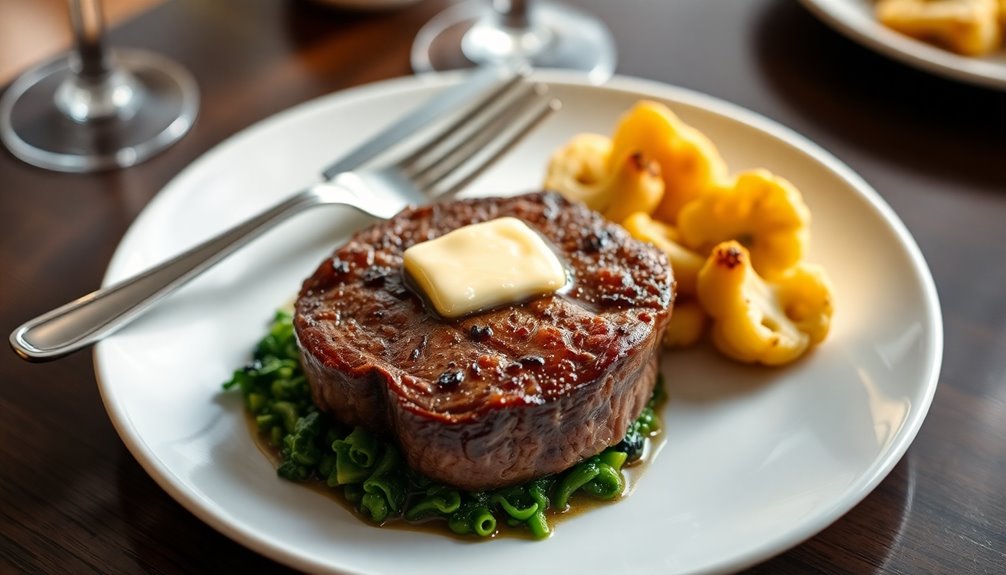
When it comes to portion control, adopting effective techniques can help you stay on track with your low-carb goals.
Start by using a smaller plate to encourage mindful eating and minimize the risk of overeating. Taking time during meals allows your body to process the emotional signals of fullness, ensuring that you consume only what you need. Savor each bite and engage in conversation, allowing your body to signal fullness. Additionally, being aware of the psychological impact of your eating habits can assist in maintaining a healthy mindset towards food. Regularly cleaning your dining area can also enhance focus during meals, promoting a healthier lifestyle choice. Research shows that user-friendly installation of meal planning tools can also simplify managing your diet.
Prioritize fats, proteins, and non-starchy vegetables, while avoiding bulk starches. If you're at a buffet, set rules beforehand to guide your choices.
Don't hesitate to skip dessert; instead, opt for coffee or tea if you're craving something sweet. Incorporating educational elements in your meal planning can further enhance your understanding of nutritional choices.
Customizing Your Meals
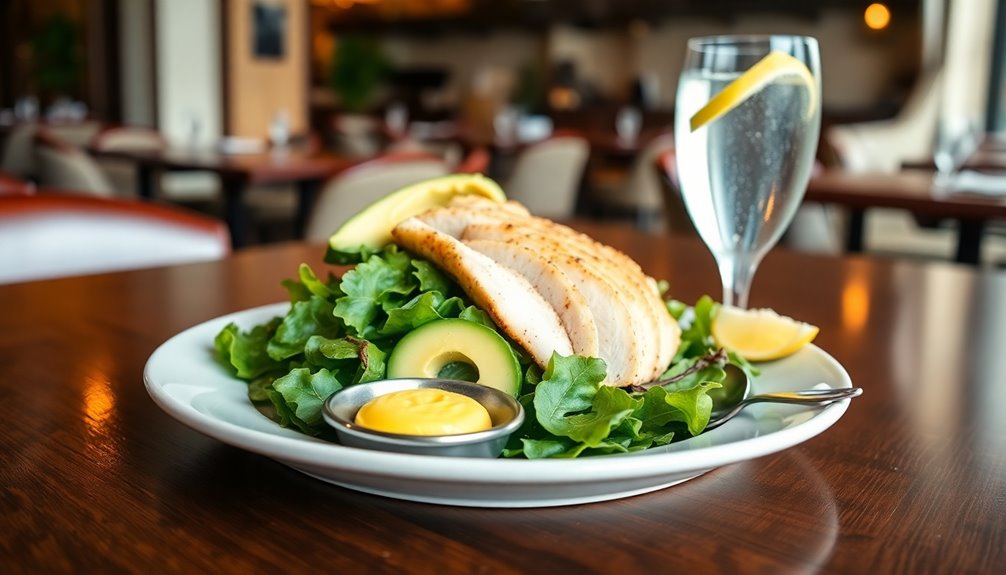
Customizing your meals is essential for staying true to your low-carb lifestyle. Don't hesitate to ask for changes to guarantee your meal fits your dietary needs.
Here are some tips to help you customize effectively:
- Request low-carb substitutions: Swap starchy sides for extra vegetables or salads. Incorporating natural ingredients can enhance the freshness of your dish. Additionally, including low-carb vegetables can significantly boost your fiber intake.
- Inquire about ingredients: Make sure to check for hidden carbs in sauces and dressings. Additionally, be aware that some sauces may contain added sugars that can increase carb counts.
- Add healthy fats: Ask for extra butter or olive oil to enhance flavor and satisfaction.
- Portion control: Request smaller portions or share dishes to avoid overeating. This can help manage your intake while still enjoying a variety of flavors.
- Consider using healthy fats to increase satiety and maintain energy levels while following your low-carb diet.
Communicating Dietary Preferences

Communicating your dietary preferences effectively can make a significant difference when dining out. Be upfront with your server about your low-carb needs. This helps guarantee you receive dishes that align with your goals. Use clear language and specify what you want or don't want in your meal.
| What to Communicate | Why It Matters |
|---|---|
| Avoid bread and pasta | Prevents unwanted carbs |
| Request extra fats | Enhances flavor and satisfaction |
| Specify sauces on the side | Control carb intake |
| Ask about hidden ingredients | Avoid unexpected sugars |
| Confirm cooking methods | Guarantees low-carb preparation |
Enjoying Low-Carb Desserts

Low-carb desserts can be a delicious way to satisfy your sweet tooth without compromising your dietary goals. When dining out, consider these tasty options:
- Cheese Plate: Pair various cheeses with olives or nuts for a satisfying treat. Essential oils can also enhance the flavor of some cheese varieties. Southern cuisine often features rich flavors that can complement a cheese platter.
- Berries with Cream: Enjoy fresh berries topped with heavy cream or whipped cream. The sweetness of the berries can be reminiscent of the classic Southern dessert, chess pie.
- Dark Chocolate: Opt for a small portion of high-quality dark chocolate (85% cocoa or higher).
- Sugar-Free Options: Look for desserts made with sugar substitutes like stevia or erythritol.
Remember to check the menu and ask about ingredients.
Many restaurants offer low-carb alternatives, so don't hesitate to explore creative options that won't derail your diet. Additionally, be mindful of air quality considerations when choosing your dining environment, as a clean atmosphere can enhance your overall dining experience.
Enjoying sweets can be both satisfying and aligned with your low-carb lifestyle!
Frequently Asked Questions
Can I Ask for Menu Items to Be Prepared Differently?
Absolutely, you can ask for menu items to be prepared differently!
Don't hesitate to request modifications that suit your dietary needs. Whether it's swapping out starchy sides for extra veggies or asking for sauces on the side, most restaurants are happy to accommodate.
Just politely communicate your preferences to the staff, and you'll often find they're willing to make adjustments to guarantee you enjoy your meal while sticking to your plan.
How Do I Handle Social Pressure for Eating Carbs?
When facing social pressure to eat carbs, stand firm in your choices. You can explain your dietary preferences confidently, emphasizing your health goals.
Focus on enjoying the company rather than the food. Engage in conversations and divert attention from your plate.
If someone offers you carbs, politely decline and suggest alternatives, like a low-carb dish you enjoy.
What Are Some Low-Carb Snacks for Dining Out?
When dining out, opt for low-carb snacks like cheese plates, olives, or nuts.
You can also enjoy veggie sticks with guacamole or ranch dressing. If you're at a restaurant, ask for meat or seafood appetizers without breading.
Don't forget to check if they've salads topped with healthy fats.
If you prepare ahead, consider packing some low-carb bars or snacks to guarantee you've got options that align with your dietary goals.
Are There Low-Carb Options for Breakfast Menus?
Imagine starting your day like a champion with a low-carb breakfast!
You've got plenty of options: order eggs any style, maybe scrambled with cheese and veggies, or an omelet loaded with avocado and bacon.
Greek yogurt with nuts can be a satisfying choice too.
If you're feeling adventurous, try a breakfast burrito in a lettuce wrap.
Just remember to skip the toast or pancakes to keep it low-carb.
Enjoy your meal!
How Can I Politely Decline Dessert at Gatherings?
When you're at a gathering, it's perfectly fine to decline dessert politely. You can say something like, "Thanks, but I'm really full from dinner."
If pressed, you might add that you're watching your sugar intake or simply prefer to enjoy a cup of coffee instead.
Most people understand and respect dietary choices, so don't feel guilty about choosing what's best for you.
Focus on enjoying the company rather than the dessert!
Conclusion
Dining out on a low-carb diet doesn't have to feel like walking a tightrope. With a little creativity and a focus on flavorful choices, you can savor every bite without guilt. Picture yourself indulging in rich, buttery dishes while steering clear of starchy sides, like a chef crafting a masterpiece. Remember, it's all about making informed decisions and communicating your needs. So go ahead, enjoy the culinary adventure, and let your taste buds dance while staying true to your goals!










